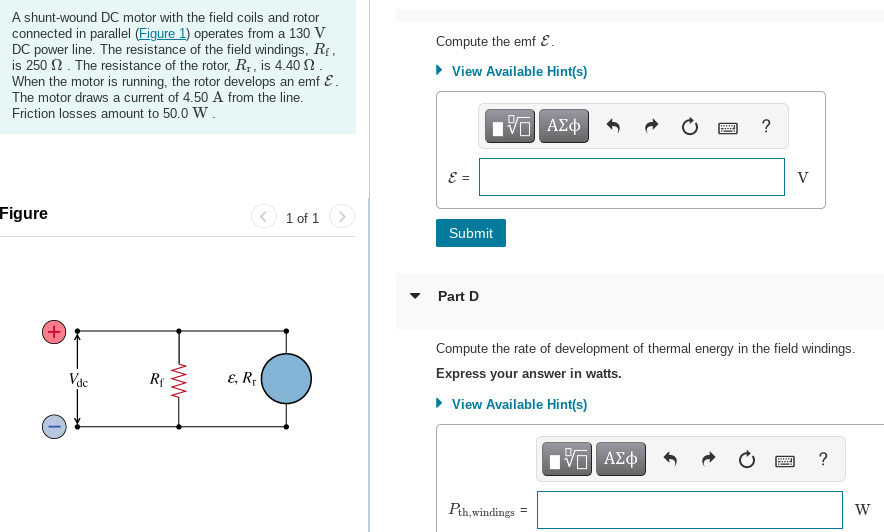A shunt-wound DC motor with the field coils and rotor connected in parallel (Figure 1) operates from a 130 V DC power line. The resistance of the field windings, Rt, is 250 N. The resistance of the rotor, R;, is 4.40 N. When the motor is running, the rotor develops an emf E. The motor draws a current of 4.50 A from the line. Compute the emf E . • View Available Hint(s) Friction losses amount to 50.0 W. νΟ ΑΣφ ? E = V Figure 1 of 1 Submit Part D + Compute the rate of development of thermal energy in the field windings. V. FR Express your answer in watts.
A shunt-wound DC motor with the field coils and rotor connected in parallel (Figure 1) operates from a 130 V DC power line. The resistance of the field windings, Rt, is 250 N. The resistance of the rotor, R;, is 4.40 N. When the motor is running, the rotor develops an emf E. The motor draws a current of 4.50 A from the line. Compute the emf E . • View Available Hint(s) Friction losses amount to 50.0 W. νΟ ΑΣφ ? E = V Figure 1 of 1 Submit Part D + Compute the rate of development of thermal energy in the field windings. V. FR Express your answer in watts.
College Physics
1st Edition
ISBN:9781938168000
Author:Paul Peter Urone, Roger Hinrichs
Publisher:Paul Peter Urone, Roger Hinrichs
Chapter23: Electromagnetic Induction, Ac Circuits, And Electrical Technologies
Section: Chapter Questions
Problem 53PE: Construct Your Own Problem Consider a double transformer to be used to create very large voltages....
Related questions
Question
100%

Transcribed Image Text:A shunt-wound DC motor with the field coils and rotor
connected in parallel (Figure 1) operates from a 130 V
DC power line. The resistance of the field windings, Rt,
is 250 N. The resistance of the rotor, R;, is 4.40 N.
When the motor is running, the rotor develops an emf E.
The motor draws a current of 4.50 A from the line.
Compute the emf E .
• View Available Hint(s)
Friction losses amount to 50.0 W.
νΟ ΑΣφ
?
E =
V
Figure
1 of 1
Submit
Part D
Compute the rate of development of thermal energy in the field windings.
Vac
Rf
E, R
Express your answer in watts.
• View Available Hint(s)
Πνα ΑΣφ
Pth,windings
W
+
Expert Solution
This question has been solved!
Explore an expertly crafted, step-by-step solution for a thorough understanding of key concepts.
This is a popular solution!
Trending now
This is a popular solution!
Step by step
Solved in 2 steps with 2 images

Knowledge Booster
Learn more about
Need a deep-dive on the concept behind this application? Look no further. Learn more about this topic, physics and related others by exploring similar questions and additional content below.Recommended textbooks for you

College Physics
Physics
ISBN:
9781938168000
Author:
Paul Peter Urone, Roger Hinrichs
Publisher:
OpenStax College

College Physics
Physics
ISBN:
9781305952300
Author:
Raymond A. Serway, Chris Vuille
Publisher:
Cengage Learning

College Physics
Physics
ISBN:
9781285737027
Author:
Raymond A. Serway, Chris Vuille
Publisher:
Cengage Learning

College Physics
Physics
ISBN:
9781938168000
Author:
Paul Peter Urone, Roger Hinrichs
Publisher:
OpenStax College

College Physics
Physics
ISBN:
9781305952300
Author:
Raymond A. Serway, Chris Vuille
Publisher:
Cengage Learning

College Physics
Physics
ISBN:
9781285737027
Author:
Raymond A. Serway, Chris Vuille
Publisher:
Cengage Learning

Physics for Scientists and Engineers: Foundations…
Physics
ISBN:
9781133939146
Author:
Katz, Debora M.
Publisher:
Cengage Learning
